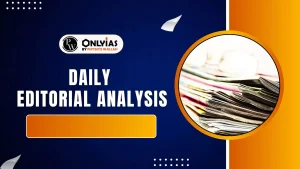Delhi is months away from dangerous pollution levels that will harm residents’ health. Development loses value if the air remains toxic.
- A clear and decisive roadmap is essential to tackle this challenge head-on.
The Current State of Pollution In Delhi
- Delhi’s air quality is alarmingly poor.
- The World Health Organisation (WHO) deems 5 units of Particulate Matter 2.5 (PM2.5) safe; however, Delhi’s PM2.5 levels in 2021 stood at a staggering 126.5 units – 25 times the safe limit.
- During winter months, this figure escalates to 300-400, reaching health emergency levels. This extreme pollution cuts average life expectancy by 6.3 years.
- The 2023 Air Quality Life Index attributes 25,000 annual deaths in Delhi to pollution.
- Economically, pollution causes a 3% loss of GDP due to health costs, productivity loss, and work disruption, disproportionately affecting the poor.
- Clean air is a fundamental human right, yet it is denied to millions in the capital.
Limitations of the Government effort in controlling Pollution
- The government has largely failed to address this crisis, relying on emergency measures like the odd-even scheme or firecracker bans.
- These actions only manage symptoms and do not attack the root cause.
- The problem is compounded by bureaucratic overlap, leading to blame games between various agencies and political entities.
- Delhi’s pollution is not an isolated city problem; it is a regional issue involving Punjab, Haryana, and Uttar Pradesh, demanding coordinated action.
Comprehensive Roadmap to Mitigation of Pollution
- Addressing Bio-mass Burning: The burning of organic fuels, cow dung cakes, and crop residue (stubble) creates a thick blanket of smoke, a recurring seasonal phenomenon.
- Action to be taken: Increase LPG adoption to 75% in NCR households, providing necessary subsidies.
- Establish community biomass plants to convert crop residue into biogas, replicating successful models like Fatehgarh Sahib.
- Curbing Industrial and Thermal Power Plant Emissions: Twelve thermal power plants (TPPs) operate in Delhi NCR, with seven still adhering to outdated 2015 emission standards, releasing excessive pollutants.
- Action to be taken: Mandate Flu Gas Desulphurisation (FGD) technology in all thermal power plants in Delhi.
- Decommission Thermal Power Plants older than 35 years, replacing them with clean technology alternatives.
- Implement quarterly emission reporting for all industrial zones in Delhi NCR.
- Enforce the installation of rooftop solar panels and the use of electric boilers in Small and Medium Enterprises (SMEs).
- Reforming Brick Kiln Operations: Over 4,600 brick kilns operate in the NCR, particularly in Western UP that cause degradation of the topsoil and contaminate groundwater.
- Action to be taken: Mandate the adoption of Zigzag technology for brick production, which reduces emissions by 60% and improves fuel efficiency.
- Incentivise kiln owners with subsidies or interest-free loans to facilitate this technological transition.
- Transforming Vehicle Fleets: Delhi has over 10 million registered vehicles, with low adoption rates for electric vehicles.
- Action to be taken: Ensure all two-wheeler deliveries are electric within 2-3 years.
- Remove/ban all two-wheelers older than 10 years from roads within 24 months.
- Transition over 300 taxis older than 8 years to electric vehicles within 2 years.
- Add 5,000 more electric buses to the public transport fleet within 3 years.
- Revolutionising Waste Management: Delhi generates 11,000 tons of solid waste daily, with over half ending up in massive landfill mountains. 70% of water flowing into the Yamuna from drains is untreated.
- Action to be taken: Strictly enforce the Surat model of waste segregation, separating organic, inorganic, wet, and dry waste at the source.
- Implement digital monitoring and impose fines on households that fail to segregate waste
- Establish decentralised Sewage Treatment Plants (STPs) at assembly and district levels, and repair existing older plants.
- Integrate waste pickers into the formal sector.
- Reclaim and transform existing landfills into green spaces.
- Broader Actions: A substantial portion of Delhi’s pollution (30-40%) originates from neighbouring states.
- Therefore, a joint clean air action plan involving Punjab, Haryana, and Uttar Pradesh is necessary.
- Unplanned urban growth, evident in the 57% increase in property rates since 2019 without commensurate infrastructure development, must be halted.
- Strict adherence to Delhi’s Master Plan, prioritising pedestrian zones, robust public transport, and green cover, is crucial.
- To further reduce vehicular emissions, private car usage must be disincentivised through higher parking rates and the implementation of congestion taxes.
- Clear Targets and Future Vision: The target is to reduce PM2.5 levels by 40-50% by 2028 compared to 2023 levels.
Conclusion
Mitigating Delhi’s pollution crisis demands a systematic and multi-faceted approach.
- With India’s population projected to reach 1.5 billion by 2036, uncontrolled urban growth, particularly in cities like Delhi, will inevitably lead to environmental collapse.
- Only through these concerted efforts can Delhi secure a breathable future
![]() 8 Aug 2025
8 Aug 2025

